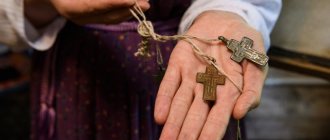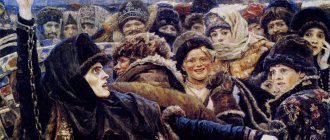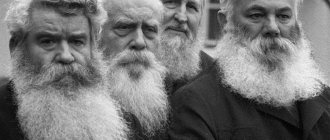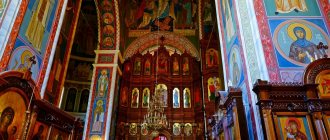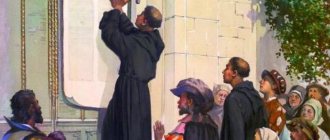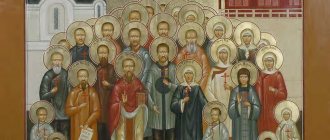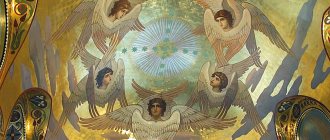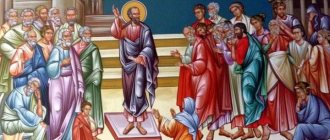In recent years, interest in the Old Believers . Many both secular and ecclesiastical authors publish materials devoted to the spiritual and cultural heritage, history and modern day of the Old Believers. However, the phenomenon of the Old Believers itself, its philosophy, worldview and features of terminology are still poorly studied. about the semantic meaning of the term “ Old Believers ” in the article “ What are Old Believers? "
Who are the Old Believers and how did they appear?
Patriarch Nikon offers new liturgical books. The beginning of the schism in 1654. Chromolithograph from a painting by Alexey Kivshenko. 1880 State Historical Museum
Old Believers are a heterogeneous religious movement within the Russian Orthodox Church. It arose in the middle of the 17th century, after the Moscow Patriarch Nikon (1605–1681) carried out a reform of the Church (more about it below). Old Believers are divided into priests and non-priests. Priests believe that only the clergy can perform the sacraments and perform rituals. There are seven sacraments: baptism, confirmation, repentance, communion, marriage, priesthood, and unction (unction). The concept of ritual is broader: it includes any ritual actions.
At the same time, bishops who had the right to ordain Ordination is one of the seven church sacraments, the elevation of a person to the clergy. The bishop literally laid his right hand on the future priest while saying a prayer. The Old Believers had no priests. Therefore, until the middle of the 19th century, fugitive Orthodox priests from the official Church who disagreed with Nikon’s reforms served with the priests. Everything changed in 1846, when the Greek Metropolitan Ambrose converted to the Old Believers: he ordained several priests and founded the Old Believer hierarchy. In the middle of the 19th century, Old Believers priests were persecuted by Emperor Nicholas I. Therefore, in 1844, the priests tried to create their own religious center in Austria. Hungary. The local government allowed the establishment of an Old Believer episcopal see in the Belokrinitsky monastery (now the territory of Ukraine). It was headed by the former Metropolitan of Bosno-Sarajevo Ambrose. This is how the Russian Orthodox Old Believers Church (ROC) appeared. However, some priests did not recognize the hierarchy established by Ambrose, and already in Soviet times, in 1923, they organized themselves into the Russian Ancient Orthodox Church (ROC).
Bespopovtsy believe that the official priesthood is devoid of divine grace, therefore there is no need for it. Among them there are many directions: Pomeranian and Chapel Consent Consent - a group of Old Believers, united by common religious practices, Fedoseevites, Filippovtsy, masons, Kerzhaks, Novospasovtsy, Netovtsy and others. In the 17th–19th centuries, the most numerous and influential movement were the Fedoseevites. They adhered to celibacy, believed that the kingdom of the Antichrist had already arrived, and, unlike other Orthodox Christians, did not pray for the king. Filippov’s people had similar views, who also preached self-immolation for the sake of saving the soul. The most radical Bespopovites were the Netovites. They believed that only Jesus Christ knew who would be saved and how, and that practically nothing depended on man. Therefore, they had no temples, no rituals (even funeral ones), only the sacrament of baptism.
How the Nizhny Novgorod land became the center of the split
What role did Nizhny Novgorod residents play in the church reforms of the 17th century and what did the local Old Believers become famous for?
Popovtsy and non-popovtsy
All these events led to the division of the Old Believers into two factions: popists (recognizing the need for priests when performing rituals) and non-popists (denying the possibility and necessity of the existence of a “correct” and “true” clergy.).
Initially, jumpers began to settle and live in sparsely populated areas, for example on the White Sea coast. For this reason, they were later called Pomeranians. They also began to open large centers in Olonetsky and Nizhny Novgorod. Later, the Besopovites developed separate movements, such as:
- Danilov;
- Fedosevsky;
- ministry;
- Spasov;
- awn.
There were also smaller branches: pit keepers, middle keepers, runners.
Money amulet “Venetian magnet”
The personal patron of prosperity and wealth has already helped thousands of people get rich: ⭐ 98% of the owners have improved their financial well-being.
⭐ 3543 owners of the amulet opened their own business. ⭐ More than 5,000 people bought luxury homes or cars. To learn more
The remaining Old Believers believed that they could use the services of priests trained in the “Nikonan Church,” but with one condition: they must curse the reforms and then receive correction. They were called beglops because they accepted “runaway” priests. The result of their work was the “Old Believer Church.”
Lestovka - ancient rite rosary, available in men's, women's and children's sizes.
The revolutionary situation in Russia at the beginning of the twentieth century led to renewal, which was joined by some Old Believers. They were headed by the vicar bishop of the Saratov diocese, Nikolai Pozdnev. As a result, the Renaissance collapsed, and in the middle of the twentieth century it ceased to exist altogether, because the Soviet government decided to support the patriarch.
Why was reform needed at all and what was its essence?
Savior Almighty. 6th century icon Ιερά Μονή Αγίας Αικατερίνης στο Όρος Σινά
It was a political move: Patriarch Nikon acted on behalf of Tsar Alexei Mikhailovich Later, the relationship between the tsar and the patriarch, who was striving to gain more and more power, deteriorated: Nikon was defrocked and exiled to a monastery as a simple monk.. In 1653, Russia annexed Left Bank Ukraine, on whose territory the Greek rite was in effect, also widespread in the Balkans and the Middle East. The Russian rite differed from the Greek one. For example, the name of Christ was written differently - Jesus, not Jesus, were baptized with two fingers, not three, and so on.
The unification of Russian and Greek rites would unite all Slavs - Eastern and Balkan - and would mark the beginning of the Great Greco-Russian Empire.
What was this unification? Firstly, in the editing of church texts. In the Old Church Slavonic translations of the Holy Scriptures and liturgical books, copied by hand, there were many discrepancies, so they were edited and brought into line with the Greek.
Secondly, instead of the two-fingered sign of the cross, the three-fingered sign of the cross was introduced. Until the mid-17th century, the raised index and middle fingers signified the divine and human nature of Christ, and three fingers pressed to the palm signified the Holy Trinity. After the reform, everything became the other way around: three folded fingers meant the Trinity, and the little finger and ring finger, pressed to the palm, meant the two natures of Christ. Instead of the procession of the cross and censing in the salting direction, that is, in the direction of the sun or clockwise, censing is the ritual of priests burning incense and other aromatic resins during the service. They also began to conduct services not on seven, but on five prosphora. Prosphora is a special bread used during services. Finally, “Hallelujah” was now repeated not two times, but three.
At first glance, these changes were completely formal. Why then did they have such a shocking effect? The fact is that an Orthodox person who lived in the middle of the 17th century did not share the ritual and dogma. Dogma is the basic position in religion, accepted on faith and not subject to criticism. The Church changed according to the dubious Greek model, but the Greeks first entered into an alliance with the Catholics , and then found themselves under the rule of Muslim Turks. For a Russian Orthodox person, confident in the truth of his own faith, this was unacceptable. Therefore, the reforms led to a split.
After the reform
All those who did not follow the new instructions and continued to make the sign of the cross with two fingers (this point became key in the dispute) were anathematized and called schismatics and heretics at the Council convened by Nikon in 1656. The Council recognized the need to correct liturgical books and in 1666 anathema the old books and rituals.
An oath is an Old Believer’s obligation to renounce the Old Believers in 1828, Novgorod province. “I, the undersigned, give this commitment to the parish priest John Pit-Gorsky in that from now on I am leaving all the errors of the Old Believer sect, in which I have been until now. And I vow not to break it. Keep all the dogmas of the true Christian faith and raise your children in it. If only God bless me. January 28, 1828. The owner Fyodor Dorofeev had a hand in this obligation of the 2nd settled company.” Taken from GANO
However, a whole movement of clergy dissatisfied with the new rules appeared: Archpriest Avvakum Petrov, Loggin Muromsky and a number of others. Entire monasteries abandoned new traditions: the Solovetsky Monastery in its entirety in 1667 refused to recognize the accepted rules, there were many other monasteries and monks. Such refusals were harshly suppressed by the army; monks were forced under torture to renounce the Old Belief, they were executed or sent to prison or exile.
New icons were painted according to new rules - saints were depicted with the three-fingered sign, which outraged adherents of the pre-reform tradition; they did not recognize these saints.
Those who denied the new church tradition officially began to be persecuted. The schismatics called themselves “ Old Orthodox Christians ”, and then “the true Orthodox Church” or “ Old Believers ”. Old Believers take root among them .
Who is Archpriest Avvakum?
Avvakum's journey through Siberia. Painting by Sergei Miloradovich. 1898 State Museum of the History of Religion, St. Petersburg
Leader and ideologist of the Old Believer movement, priest and writer. In the 1640s, he, along with the future Patriarch Nikon, was a member of the Moscow circle of zealots of piety. The circle of zealots of piety was a circle of clergy and secular persons that existed in the late 1640s and early 1650s. It was founded by Stefan Vonifatiev, the confessor of Tsar Alexei Mikhailovich, whose participants wanted to improve the situation in the country by establishing strict piety and forcing society to honor God and follow religious precepts. The members of the circle did not support the reforms: the “zealots of piety” wanted to edit liturgical texts according to ancient Russian Orthodox models, and not at all according to Greek ones. As a sign of protest, Avvakum wrote a petition - a letter with a request or complaint, submitted to the tsar or local authorities until the 18th century. king, but paid for it. In 1653, he was arrested, thrown into the basement of the Andronikov Monastery in Moscow, then exiled to Tobolsk, and from there to Transbaikalia.
Ten years later, Avvakum returned to Moscow. By that time, Patriarch Nikon was already in disgrace, and Alexei Mikhailovich reacted to Avvakum much more favorably. But a year later, the rebellious archpriest again wrote a petition in which he was indignant at the Russian Orthodox Church, and was again exiled - this time to the Arkhangelsk region. In 1666, he was brought to the capital and cut off his hair there, which caused great popular outrage.
Over the next year, Avvakum's associates were executed, and he was whipped and exiled to Pustozersk Pustozersk , a disappeared city in the lower reaches of the Pechora River, located on the territory of what is now the Nenets Autonomous Okrug, where he lived for the next 14 years. In exile, he wrote most of his works, including the famous “Life of Archpriest Avvakum,” which is considered the first Russian autobiography.
From exile, Avvakum actively sent letters and messages, among which was a letter to Tsar Fyodor Alekseevich criticizing the policies of his father and Patriarch Joachim. As a result, in 1682, Avvakum and some of his comrades were burned in a log house. Burning in a log house is a type of execution that arose in Russia in the 16th century and was actively used against Old Believers after the schism of the Church in the middle of the 17th century.
What did Habakkuk do?
How the autobiography of a schismatic expressed the contradictions of the era
How do Old Believers differ from Orthodox Christians?
Each Old Believer movement may have its own exceptional characteristics acquired over many years, but they are all united by a special church worldview based on “Old Orthodox” traditions.
They cross themselves with two fingers.
A four-pointed cross without a Crucifix, or an eight-pointed cross with a Crucifix.
Baptism is carried out with triple immersion.
All letter and text changes in the theological books adopted by Nikon during the reform are absent; prayers and texts are read in the old way.
Singing in church should only be unison.
The procession of the cross is not carried out against the sun, as in Orthodoxy, but in the direction of the sun.
Are Old Believers and Old Believers the same thing?
Old Believers in the cemetery. Late 19th - early 20th century Wikimedia Commons
Most scientists believe yes. But in recent years, a polar point of view has emerged: its supporters call the Old Believers the bearers of traditional Russian folk religiosity, which included, among other things, elements of paganism. The future leaders of the Old Believers, before they opposed the pro-Greek reforms and entered into confrontation with Tsar Alexei Mikhailovich and Patriarch Nikon, fought for the purity of the faith and the elimination of those distortions that appeared under the influence of folk traditions. For example, they struggled with fortune telling, superstitions, magical practices and games. The same archpriest Avvakum really did not like buffoons.
The religious consciousness of an educated theologian and an ordinary parishioner today can differ significantly. Archpriest Avvakum and Patriarch Nikon were closer to each other than to the contemporary peasant, the bearer of popular religiosity. They disagreed not over the need for reforms, but over their methods. But most researchers still continue to use the concepts of “Old Belief” and “Old Believers” as synonyms, because folk religiosity is present in any tradition, including the official Russian Orthodox Church, and there is no point in distinguishing it as a special tradition.
Background to the schism of the Russian Church
Christianity , brought to Russia from Byzantium, was based on Byzantine traditions. All Russian texts of books, including the Holy Scriptures, were translations.
Traditional rituals and elements of worship were not taken from books, but were transmitted orally between clergy. In this connection, at the end of the 16th century, a dispute arose about how many fingers should be baptized. documentary written sources strictly defining the tradition of the “ sign of the cross ”.
two fingers were adopted (they were baptized with two fingers). While in Greece in the 13th century they adopted triplicate. There were other differences that, as they accumulated, greatly separated the Moscow Church and the Greek Church.
Since Greece was considered a kind of successor and continuer of Byzantine traditions, the Russian Church carefully looked at new trends in Greek culture, gradually introducing them into its own country.
For example, the Russian clergy, long before the 17th century, began to wear clothes similar to the Greek clergy, and then they introduced the tradition of wearing long hair, etc.
Why were the Old Believers so hated and persecuted?
Self-immolators. Painting by Grigory Myasoedov. 1882–1884 State Tretyakov Gallery
The cruelty of persecution was determined, on the one hand, by the severity of the legal practices of that era, on the other, by the firmness of opponents of reforms, which turned into fanaticism, even self-immolation. Particularly interesting is the phenomenon of Gari - mass self-immolations of Old Believers. According to various estimates, in the second half of the 17th century, over 8,000 people died in self-immolations. Some researchers explain it by the pressure of external circumstances and the lack of choice: Old Believers were forcibly converted to official Orthodoxy. Others believe that self-immolations are related to the Old Believer doctrine itself: the Old Believers believed that self-immolation cleanses sins. And although the pressure on the Old Believers gradually began to decrease, taking on less radical forms, the persecution continued until April 1905, when Nicholas II issued a decree on religious tolerance, establishing freedom of choice of religion and ending the persecution of the Old Believers. Only in 1971 did the Russian Orthodox Church lift the anathemas Anathema is the highest church punishment, excommunication. from the Old Believers.
Old Believers or Old Believers?
From time to time, a discussion arises among Old Believers of all agreements: “ Can they be called Old Believers ?” Some argue that it is necessary to call ourselves exclusively Christians because no old faith and old rituals exist, as well as a new faith and new rituals. According to such people, there is only one true, one right faith and only true Orthodox rituals, and everything else is heretical, non-Orthodox, crooked Orthodox confession and wisdom.
Others, as mentioned above, consider it absolutely obligatory to be called Old Believers, professing the old faith, because they believe that the difference between the Old Orthodox Christians and the followers of Patriarch Nikon is not only in rituals, but also in the faith itself.
Still others believe that the word Old Believers should be replaced with the term “ Old Believers .” In their opinion, there is no difference in faith between the Old Believers and the followers of Patriarch Nikon (Nikonians). The only difference is in the rituals, which among the Old Believers are correct, while among the Nikonians they are damaged or completely incorrect.
There is a fourth opinion regarding the concept of Old Believers and the old faith. It is shared mainly by the children of the Synodal Church. In their opinion, between the Old Believers (Old Believers) and the New Believers (New Believers) there is not only a difference in faith, but also in rituals. They call both old and new rituals equally honorable and equally salutary. The use of one or another is only a matter of taste and historical and cultural tradition. This is stated in the resolution of the Local Council of the Moscow Patriarchate of 1971.
Did the Old Believers live closed, were they hermits?
Nicholas II receives bread and salt from the Yaroslavl Old Believer Voznesensk community. 1913 Wikimedia Commons
Hermitage is a form of monasticism characteristic of all traditional Christian denominations. A denomination is a type of religious organization that unites believers who adhere to the same religion within a certain religious tradition. Hermits and hermits were among Catholics and among ordinary Orthodox Christians, but Old Believers were more likely to become hermits against their will. They chose isolation to hide from the authorities and maintain the purity of their faith - through chastity, abstinence from alcohol and European dress. The priestless Old Believers even believed that one could become defiled through sharing a meal and communicating with heretics, infidels, or non-believers.
What do Old Believers believe?
The Old Believers, as the heirs of pre-schism, pre-reform Russia, try to preserve all the dogmas, canonical provisions, ranks and followers of the Old Russian Church.
First of all, of course, this concerns the main church dogmas: the confession of St. Trinity, the incarnation of God the Word, two hypostases of Jesus Christ, his atoning Sacrifice on the Cross and Resurrection. The main difference between the confession of the Old Believers and other Christian confessions is the use of forms of worship and church piety characteristic of the ancient Church.
Among them are the two-fingered sign of the cross, immersion baptism, unison singing, canonical iconography, and special prayer clothing. For Divine services, the Old Believers use old printed liturgical books published before 1652 (mainly published under the last pious Patriarch Joseph. The Old Believers , however, do not represent a single community or church - for hundreds of years they were divided into two main directions: priests and non-priests.
Were there many wealthy entrepreneurs and philanthropists among them?
Representatives of four branches of the Morozov family. Early 1860s From left to right: Abram Abramovich Morozov (left), Timofey Savvich Morozov (sitting in the center), Ivan Zakharovich Morozov and Vikula Eliseevich Morozov.
Church of the Assumption of the Blessed Virgin Mary in Putinki There was such a phenomenon as the Old Believer merchants. Discipline, strict rules, which extended to the business sphere, mutual assistance - all this contributed to economic success. Thanks to mutual responsibility Mutual responsibility is the group responsibility of everyone for everyone and everyone for everyone. and tribal solidarity, the Old Believers community could play the role of banks, entering into financial relations on parole. The Old Believers took care of their workers: they built hospitals, almshouses, and libraries. The literacy rate among Old Believers as a whole was higher than in the country.
Old Believer communities were very rich, and their members played an important role in the development of Russian industry. The Morozovs, Ryabushinskys, Gromovs, Avksentievs, Buryshkins, Guchkovs, Konovalovs, Prokhorovs, Soldatenkovs, Tretyakovs, Khludovs, Bugrovs - all these are Old Believer dynasties. With the introduction of religious tolerance and the constitutional principles of the monarchy in 1905, Old Believers-entrepreneurs tried to become the basis of young Russian capitalism.
Have they always had long beards?
Lubok of the 18th century The barber wants to cut the beard of a schismatic.
The Raskolnik says to the barber: “Listen, barber! I don't want to cut my beard. Look, the guard will soon shout at you.” ifroney.com Even today, Old Believers not only do not shave their beards, but also do not cut it. Before the reforms of Peter I, all men wore beards. The Old Believers remained faithful to this tradition, as well as to other pre-reform norms. The introduction of shaving seemed to be additional evidence of the fall of the Russian kingdom into heresy and the advent of the kingdom of Antichrist. The situation was further aggravated by the fact that in the West everyone shaved, and the Old Believers considered Europeans to be heretics.
How to behave in an Old Believer church
Before entering the church, you need to stand up and listen to what is being read or sung in the church. If you can walk through this place, first make parish bows, then stand and do not leave this place until the end of the service.
Important: men always sit to the right of the church, and women to the left. In parishes in Ukraine and Moldova, where there are more men in the church, they line up in front and women in the back.
While praying, stand straight, feet together, heels together, toes apart. Your arms should be folded horizontally, with your right hand on top. The bows must be performed simultaneously in accordance with the provisions of the Statute.
If you stand on your hands while praying, your hands will be clean.
It is recommended to use a stretcher during the Lord's Prayer exercises. The priests always go to the cross first, then the men, then the women.
It is prohibited in the church:
- on the knees;
- kiss icons, except in appropriate cases;
- speak during the service;
- pray or attend sacraments (for non-Old Believers);
- make sound, photo or video recordings without permission.
Women are not allowed to wear hats or caps in church, and their heads must be covered with a headscarf. Clothing that in any way emphasizes the shape of the body, as well as high-heeled shoes, are prohibited. Trousers, low necklines, jeans, etc. are not allowed. Before the service, you should remove your purses and wear perfume. Mobile phones should be placed on silent mode, as should other gadgets that may make noise.
Important: When asking questions, use as few words or body language as possible. It is better to wait until the end of the service, then all questions will be answered fully.
How were Old Believers treated in the USSR?
Old Believer prayer room in Luzhki Posad. Photo by E. Frolov. 1925 State Archives of the Bryansk Region
Due to the fact that the Old Believers supported the White movement, the Soviet government considered them enemies. However, the persecution did not begin immediately, but with collectivization, which virtually destroyed the Old Believer communities.
There is also the opposite opinion: the Old Believers took an active part in the revolution and supported Soviet power, because the monarchy persecuted them for many years. Therefore, some of them participated in the February Revolution and were members of the Provisional Government The Provisional Government is the highest body of Russian state power in March - October 1917, for example Alexander Guchkov. The richest industrialist Savva Morozov also supported the Bolsheviks.
At the same time, the role of the Old Believers in the events of 1917 should not be exaggerated: the February Revolution was generally welcomed by all layers of Russian society, including the official Orthodox Church.
The contradictions between the Old Believers and the revolutionaries were too great. The Bolsheviks sought to modernize society, while the Old Believers were traditionalists and conservatives. They did not want to live in Soviet society, they did not want to give secular and especially Soviet education to their children, and they considered collective farms to be anti-Christ institutions. In the 1930s, they fell under the wheel of repression and shared the fate of representatives of other religious movements. It is interesting that in the Baltic states and Poland, unlike the USSR, in the 1920s and 30s there was a flourishing of Old Believer communities. But after the annexation of Estonia, Latvia and Lithuania to the USSR in August 1939 and the events of World War II, the Old Believer communities in these regions were either destroyed or emigrated to the West - mainly to North and South America.
Old Believers or Old Believers?
For a long time, in government and church documents, Orthodox Christians who preserved ancient liturgical rites, early printed books and customs were called “ schismatics .” They were accused of being faithful to church tradition, which allegedly led to a church schism. For many years, schismatics were subjected to repression, persecution, and infringement of civil rights.
However, during the reign of Catherine the Great, attitudes towards the Old Believers began to change. The Empress believed that the Old Believers could be very useful for settling the uninhabited areas of the expanding Russian Empire.
At the suggestion of Prince Potemkin, Catherine signed a number of documents granting them rights and benefits to live in special areas of the country. In these documents, the Old Believers were named not as “schismatics,” but as “Old Believers,” which, if not a sign of goodwill, undoubtedly indicated a weakening of the state’s negative attitude toward the Old Believers. Old Orthodox Christians, Old Believers , however, did not suddenly agree to the use of this name. In apologetic literature and the resolutions of some Councils it was indicated that the term “Old Believers” was not entirely acceptable.
It was written that the name “Old Believers” implies that the reasons for the church division of the 17th century lay in the same church rituals, while the faith itself remained completely intact. Thus, the Irgiz Old Believer Council of 1805 called co-religionists “Old Believers,” that is, Christians who use old rituals and old printed books, but obey the Synodal Church. The resolution of the Irgiz Cathedral read:
Others retreated from us to the renegades, called Old Believers, who, like us, keep old printed books and conduct services from them, but have no shame in communicating with everyone in everything, both in prayer and in eating and drinking.
In the historical and apologetic writings of the Old Orthodox Christians of the 18th - first half of the 19th centuries, the terms “Old Believers” and “Old Believers” continued to be used. They are used, for example, in the “History of the Vygovskaya Hermitage” by Ivan Filippov, the apologetic work “Deacon’s Answers” and others. This term was also used by numerous New Believer authors, such as N.I. Kostomarov, S. Knyazkov. P. Znamensky, for example, in the 1870 edition of the “Guide to Russian History” says:
Peter became much stricter towards the Old Believers.
At the same time, over the years, some Old Believers began to use the term “ Old Believers .” Moreover, as the famous Old Believers writer Pavel the Curious (1772–1848) points out in his historical dictionary, the name Old Believers is more characteristic of non-priestly concords, and “Old Believers” - to persons belonging to concords that accept the fleeing priesthood.
And indeed, by the beginning of the 20th century, the agreements that accepted the priesthood (Belokrinitsky and Beglopopovsky) began to increasingly use Old Believers , Old Believers ” . Soon the name Old Believers was enshrined at the legislative level by the famous decree of Emperor Nicholas II “On strengthening the principles of religious tolerance.” The seventh paragraph of this document reads:
To assign the name Old Believers , instead of the currently used name of schismatics, to all followers of rumors and agreements who accept the basic dogmas of the Orthodox Church, but do not recognize some of the rituals accepted by it and conduct their worship according to old printed books.
However, even after this, many Old Believers continued to be called Old Believers . The non-priest consents especially carefully preserved this name. D. Mikhailov, author of the magazine “Native Antiquity”, published by the Old Believer circle of adherents of Russian antiquity in Riga (1927), wrote:
Archpriest Avvakum speaks about the “old Christian faith,” and not about “rites.” Old Believer” found anywhere .



